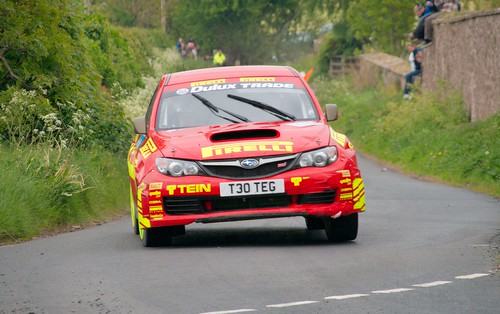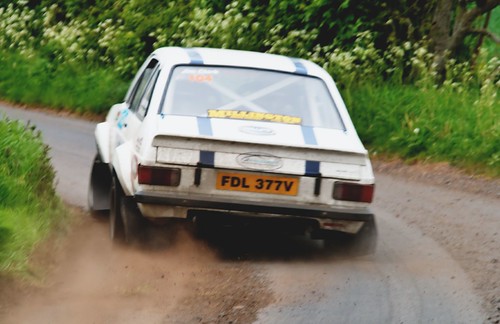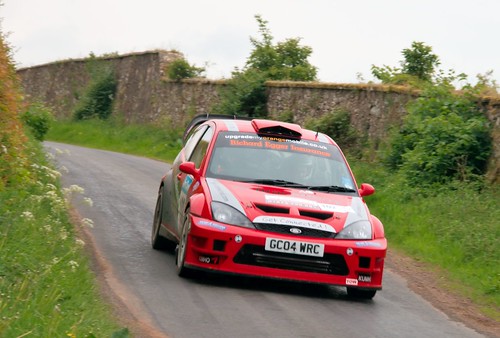Stage-side
At first, you hear only the distant sound of a car engine, straining against its rev-limiter like a dog against its leash, interleaved with the low crackle of the exhaust on the over-run. For a minute or two it echoes across the valley, but doesn't seem to be getting any louder, any closer. Then, suddenly, it appears. Rear end fish-tailing slightly as the tyres struggle for purchase on the damp tarmac, it rounds the tight 90 degree left-hander and its barreling straight towards you, at an ever increasing velocity. Building from 30mph to nearer 100 in the space of a few seconds. Then just as it seems its never going to slow down, that a tonne or more of Mitsubishi Lancer Evo. 10 rally car is going to come ploughing straight on through the barbed-wire fence and make mince-meat of you, the driver jams the brakes, the front of the car dips under the force being applied, and the car is pitched into an elegant four-wheel drift through the left-hander you are standing on the outside of, tearing up a chunk of turf from the inside verge as he goes. And then he's on his way again, banging back up through the gears, the sound of the engine becoming steadily fainter as he disappears down the narrow sing;e-track road, into the distance. There'll be another one along in a minute...

I struggle to think of any other sport where a spectator, watching the event live and in person, has less insight into what is actually happening, less idea of who is in the fight for victory and who has little chance of winning, than in the case with rallying. On each stage, you see the cars for just a few seconds, and perhaps two or three corners at the most. Even if you have an intuitive feel for their pace over those two or three corners, you cannot know whether it's representative of their performance over the stage as a whole, which might be fifteen miles long, and consist of hundreds of corners. Watching the penultimate stage of the Jim Clark Rally last weekend, I had literally no idea who was in contention for the win, and who was minutes or more off the leader's pace, with no realistic chance of victory. I had no idea, until I got back to the ceremonial finish area in the village of Duns, that Gwyndaf Evans, a man whom I remember seeing in action in a lurid-pink coloured Sierra RS Cosworth in the late 1980s, had finally broken his Jim Clark Rally duck and won the event in his Mitsubishi Lancer.

So why did I bother to make the trip? And more to the point, why was I joined by what I would guess, based on the evidence of a single stage (Wedderburn, in case you're curious), was a larger crowd than any other motorsport event in Scotland bar the BTCC and British Superbike rounds at Knockhill? The answer, in short, is that there is no other form of motorsport that has such an immediate, visceral, visual impact - that lets you get so close to the action, and which is so obviously a challenge for the driver. It may be every bit as difficult to get a really good time out of a low-powered single-seater but it doesn't look half as much of a challenge as getting the quickest possible time out of a 300BHP rally car on a damp single-track road on cut slick tyres. And 80 or 90mph might look very pedestrian on the wide open expanses of Silverstone, but it looks pretty bloody hair-raising on a narrow, pot-holed country lane with an eight foot stone wall on one side and a ditch on the other.
One thing that did surprise me though, was how much more entertaining the National-class event that ran behind the British Rally Championship counter that was the main event. While the main event was contested by Group N and Super 2000 cars (though the only competitive Super 2000 car, Craig Breen's Fiesta, had gone out of the event by the time I was watching), the National event seemed to serve as a kind of graveyard for top-line rally cars from the past thirty years. Damian Cole won that event in an ex M-Sport Focus WRC, but he was pushed all the way by Simon Mauger in, of all things, a Mk. 2 Escort which was far and away the most spectacular car through the bit of the Wedderburn stage I saw, the combination of rear wheel drive, a thirty year old chassis and bundles of horsepower on a by then rather wet surface looking a real handful.

Even if the cars hadn't been as spectacular as they were, there was something very refreshing about the sheer variety of the machinery. Rather than endless Subaru Imprezas and Mitsubishi Lancers, there was a Focus WRC, a Skoda Fabia WRC, several very quick Mk. 2 Escorts and, yes, a lot of Mitsubishis and Subarus. There was even an ersatz Metro 6R4 (though it had been entered into a previous rally as a 'Metro 4R2', reflecting the fact that it was in 2WD and had a 4 cylinder engine.) I appreciate that such an approach could hardly be expected to work in the big-money world of the World Rally Championship, where such open and free technical regulations would soon get out of hand. But if the people running the WRC really want to reconnect with fans, to create a real spectacle, how about mandating rear wheel drive?

(All photographs author's own.)

I struggle to think of any other sport where a spectator, watching the event live and in person, has less insight into what is actually happening, less idea of who is in the fight for victory and who has little chance of winning, than in the case with rallying. On each stage, you see the cars for just a few seconds, and perhaps two or three corners at the most. Even if you have an intuitive feel for their pace over those two or three corners, you cannot know whether it's representative of their performance over the stage as a whole, which might be fifteen miles long, and consist of hundreds of corners. Watching the penultimate stage of the Jim Clark Rally last weekend, I had literally no idea who was in contention for the win, and who was minutes or more off the leader's pace, with no realistic chance of victory. I had no idea, until I got back to the ceremonial finish area in the village of Duns, that Gwyndaf Evans, a man whom I remember seeing in action in a lurid-pink coloured Sierra RS Cosworth in the late 1980s, had finally broken his Jim Clark Rally duck and won the event in his Mitsubishi Lancer.

So why did I bother to make the trip? And more to the point, why was I joined by what I would guess, based on the evidence of a single stage (Wedderburn, in case you're curious), was a larger crowd than any other motorsport event in Scotland bar the BTCC and British Superbike rounds at Knockhill? The answer, in short, is that there is no other form of motorsport that has such an immediate, visceral, visual impact - that lets you get so close to the action, and which is so obviously a challenge for the driver. It may be every bit as difficult to get a really good time out of a low-powered single-seater but it doesn't look half as much of a challenge as getting the quickest possible time out of a 300BHP rally car on a damp single-track road on cut slick tyres. And 80 or 90mph might look very pedestrian on the wide open expanses of Silverstone, but it looks pretty bloody hair-raising on a narrow, pot-holed country lane with an eight foot stone wall on one side and a ditch on the other.
One thing that did surprise me though, was how much more entertaining the National-class event that ran behind the British Rally Championship counter that was the main event. While the main event was contested by Group N and Super 2000 cars (though the only competitive Super 2000 car, Craig Breen's Fiesta, had gone out of the event by the time I was watching), the National event seemed to serve as a kind of graveyard for top-line rally cars from the past thirty years. Damian Cole won that event in an ex M-Sport Focus WRC, but he was pushed all the way by Simon Mauger in, of all things, a Mk. 2 Escort which was far and away the most spectacular car through the bit of the Wedderburn stage I saw, the combination of rear wheel drive, a thirty year old chassis and bundles of horsepower on a by then rather wet surface looking a real handful.

Even if the cars hadn't been as spectacular as they were, there was something very refreshing about the sheer variety of the machinery. Rather than endless Subaru Imprezas and Mitsubishi Lancers, there was a Focus WRC, a Skoda Fabia WRC, several very quick Mk. 2 Escorts and, yes, a lot of Mitsubishis and Subarus. There was even an ersatz Metro 6R4 (though it had been entered into a previous rally as a 'Metro 4R2', reflecting the fact that it was in 2WD and had a 4 cylinder engine.) I appreciate that such an approach could hardly be expected to work in the big-money world of the World Rally Championship, where such open and free technical regulations would soon get out of hand. But if the people running the WRC really want to reconnect with fans, to create a real spectacle, how about mandating rear wheel drive?

(All photographs author's own.)
Labels: british rally championship, gwyndaf evans, jim clark rally, rallying, wedderburn


0 Comments:
Post a Comment
<< Home